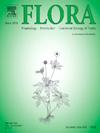Anther development in gourd tree (Crescentia cujete, Bignoniaceae): implications for the evolutionary transition between basic and dicotyledonous types of microsporangium wall formation
IF 1.8
4区 生物学
Q3 ECOLOGY
引用次数: 0
Abstract
In this study, we compared anther development in C. cujete with those of other Bignoniaceae and some related taxa. Our goal was to investigate the ontogeny of microsporangium wall layers, microsporogenesis, and pollen development, in order to provide data useful for studies of the evolution of morphoanatomical features of the anther and to contribute for the embryology of Bignoniaceae. As in other Bignoniaceae, the horseshoe microsporangium of C. cujete exhibits a secretory dimorphic tapetum with dual origin and a parenchymatous placentoid. These features have been also observed in several other asterid families. However, the parenchymatous placentoid in C. cujete and other species of Bignoniaceae is a connective outgrowth, which differs from the septum-derived condition of this structure in certain families. Microsporogenesis and pollen development also proceed as in other species of Bignoniaceae, and the pollen grains are shed at the bicelled stage. The multilayered endothecium with bands of wall thickenings is restricted to four specific sites of the anther. Stomium rupture involves the action of epidermal cells only, but the anther wall opening appears to arise from a combination of the mechanical action of the multilayered endothecium and cell collapse in specific parts of the connective tissue. Formation of the anther wall layers in C. cujete conforms to both basic and dicotyledonous modes (i.e., centripetal and centrifugal derivation of the outer tapetum, respectively), which is congruent with plasticity in the evolutionary transition between these conditions.
葫芦(月桂科)花药发育:微孢子囊壁形成从基型到双子叶型的进化过渡的意义
在本研究中,我们比较了大戟科其它植物及其相关分类群的花药发育情况。研究小孢子囊壁层的发生、小孢子的发生和花粉的发育,为进一步研究大戟科植物花药的形态解剖学特征和胚胎学研究提供数据。与其他大戟科植物一样,马蹄形小孢子囊具有双重起源的分泌二态绒毡层和薄壁胎盘样。在其他几个小行星族中也观察到这些特征。然而,C. cujete和其他biignoniaceae物种的薄壁类胎盘是一种结缔组织,不同于某些科中这种结构的隔膜衍生状态。小孢子的发生和花粉的发育也像其他种类的大戟科植物一样进行,花粉粒在双胞期脱落。具有壁增厚带的多层内壁局限于花药的四个特定部位。气孔破裂只涉及表皮细胞的作用,但花药壁的打开似乎是由多层被膜的机械作用和结缔组织特定部位的细胞塌陷共同引起的。花药壁层的形成既符合基本模式,也符合双子叶模式(即外绒毡层分别为向心衍生和离心衍生),这与这两种模式之间的进化过渡过程中的可塑性是一致的。
本文章由计算机程序翻译,如有差异,请以英文原文为准。
求助全文
约1分钟内获得全文
求助全文
来源期刊

Flora
生物-植物科学
CiteScore
3.30
自引率
10.50%
发文量
130
审稿时长
54 days
期刊介绍:
FLORA publishes original contributions and review articles on plant structure (morphology and anatomy), plant distribution (incl. phylogeography) and plant functional ecology (ecophysiology, population ecology and population genetics, organismic interactions, community ecology, ecosystem ecology). Manuscripts (both original and review articles) on a single topic can be compiled in Special Issues, for which suggestions are welcome.
FLORA, the scientific botanical journal with the longest uninterrupted publication sequence (since 1818), considers manuscripts in the above areas which appeal a broad scientific and international readership. Manuscripts focused on floristics and vegetation science will only be considered if they exceed the pure descriptive approach and have relevance for interpreting plant morphology, distribution or ecology. Manuscripts whose content is restricted to purely systematic and nomenclature matters, to geobotanical aspects of only local interest, to pure applications in agri-, horti- or silviculture and pharmacology, and experimental studies dealing exclusively with investigations at the cellular and subcellular level will not be accepted. Manuscripts dealing with comparative and evolutionary aspects of morphology, anatomy and development are welcome.
 求助内容:
求助内容: 应助结果提醒方式:
应助结果提醒方式:


